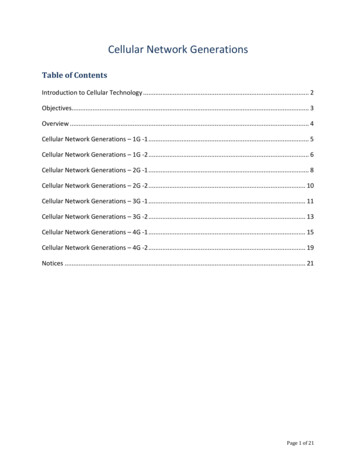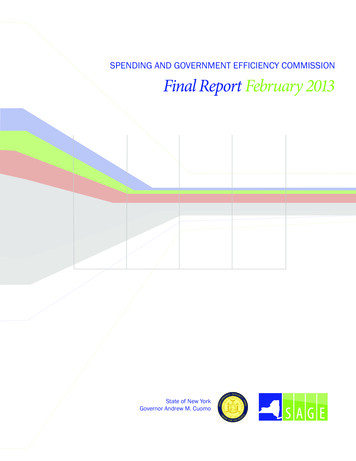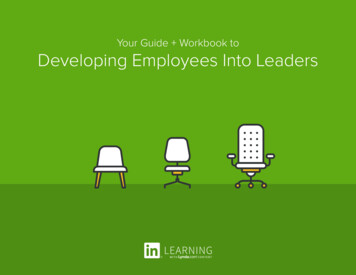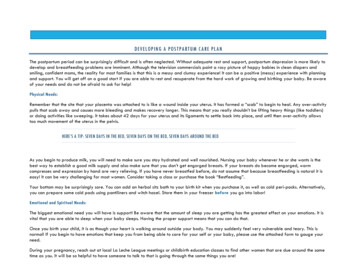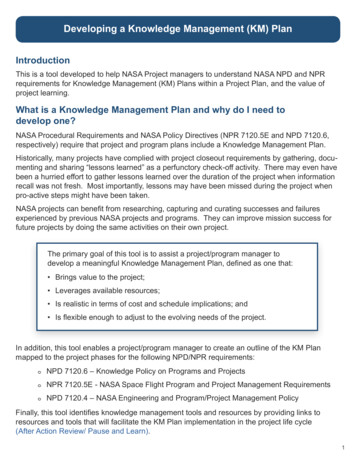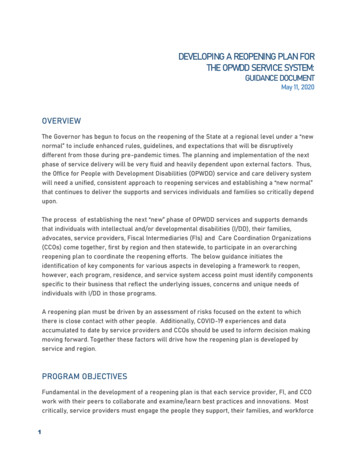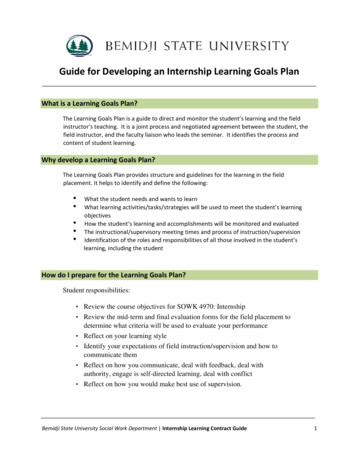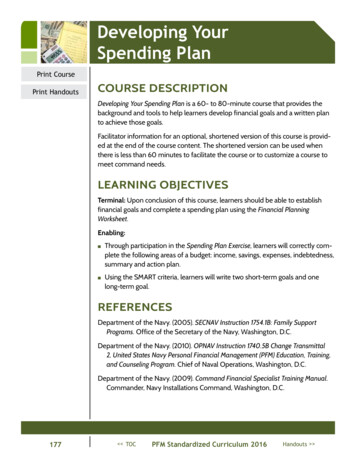
Transcription
Developing YourSpending PlanPrint CoursePrint HandoutsCOURSE DESCRIPTIONDeveloping Your Spending Plan is a 60- to 80-minute course that provides thebackground and tools to help learners develop financial goals and a written planto achieve those goals.Facilitator information for an optional, shortened version of this course is provided at the end of the course content. The shortened version can be used whenthere is less than 60 minutes to facilitate the course or to customize a course tomeet command needs.LEARNING OBJECTIVESTerminal: Upon conclusion of this course, learners should be able to establishfinancial goals and complete a spending plan using the Financial PlanningWorksheet.Enabling:O Through participation in the Spending Plan Exercise, learners will correctly complete the following areas of a budget: income, savings, expenses, indebtedness,summary and action plan.O Using the SMART criteria, learners will write two short-term goals and onelong-term goal.REFERENCESDepartment of the Navy. (2005). SECNAV Instruction 1754.1B: Family SupportPrograms. Office of the Secretary of the Navy, Washington, D.C.Department of the Navy. (2010). OPNAV Instruction 1740.5B Change Transmittal2, United States Navy Personal Financial Management (PFM) Education, Training,and Counseling Program. Chief of Naval Operations, Washington, D.C.Department of the Navy. (2009). Command Financial Specialist Training Manual.Commander, Navy Installations Command, Washington, D.C.177TOCPFM Standardized Curriculum 2016Handouts
Developing Your Spending Plan“Consumer Expenditure Survey.” Bureau of Labor Statistics. U.S. Department ofLabor, n.d. Web. July 21, 2014. www.bls.gov/cex/Kiplinger’s Practical Guide to Your Money: Keep More of It, Make it Grow, Enjoy It,Protect It, Pass It On, 3rd ed. New York: Kaplan Publishing, 2005.Garman, E.T., and R.E. Forgue. (2011). Personal Finance, 11th ed. Boston, MA:Houghton Mifflin Company.Jacobe, Dennis. “One in Three Americans Prepare a Detailed Household Budget.”Gallup Economy. Gallup Inc., June 3, 2013. Web. July 21, 2014. pare-detailed-household-budget.aspx“National Income and Product Accounts Tables.” U.S. Bureau of Economic Analysis.U.S. Department of Commerce, n.d. Web. July 21, 2014. www.bea.gov/iTable/iTable.cfm?reqid 9&step 1&acrdn 2 - reqid 9&step 3&isuri 1&903 76Voight, Kevin. “8 Habits of Self-Made Millionaires.” NerdWallet Finance.NerdWallet Inc., March 26, 2014. Web. July 21, 2014. /8-habits-selfmade-millionaires/USEFUL WEBSITES:www.edmunds.com (Edmunds website to calculate car values)www.homegain.com (HomeGain website to calculate home values)www.kbb.com (Kelley Blue Book website to calculate car values)www.nada.com (National Automobile Dealers Association website to calculate carvalues)www.savingsbond.gov (U.S. Treasury website to calculate the value of savings bonds)www.bankrate.com (Bankrate Inc. for financial rates and education)COURSE PREPARATIONHandouts:O Debt-to-Income RatioO Financial Planning PyramidO Financial Planning WorksheetO Financial Planning Worksheet Checklist178TOCPFM Standardized Curriculum 2016Handouts
Developing Your Spending PlanO Sources of Help for Military ConsumersO Spending Plan ExerciseMaterials (vary depending on activities chosen):O Pens, pencils, paperO Internet access (optional)O Developing Your Spending Plan PowerPoint slidesO Bowling for Budgets PowerPoint review gameSUMMARY OF LEARNER ACTIVITIESO Spending Plan Exercise: A scenario-based activity in which learners practicecompleting a financial planning worksheet.O Bowling for Budgets review game (optional): An optional PowerPoint game thatcan be used for presentation of course content or in lieu of lecture or as a review.CONTENT OUTLINE1. Welcome and Introduction (5 minutes)a. Topic Overviewb. Agenda2. Successful Financial Management (10 minutes)a. The Financial Planning Pyramidb. Spending Plansi. Effective Plansii. Benefits3. The Financial Planning Worksheet (40 minutes)a. Net Worth Sectionb. Cash Flow or Budget Sectioni. Incomeii. Savingsiii. Learner Activity: Spending Plan Exercise – Income and Savingsiv. Living Expensesv. Learner Activity: Spending Plan Exercise — Living Expenses179TOCPFM Standardized Curriculum 2016Handouts
Developing Your Spending Planc.d.e.f.g.h.vi. Indebtednessvii. Summaryviii. Learner Activity: Spending Plan Exercise — Indebtedness andSummaryYour Debt-to-Income RatioYour Action PlanSetting SMART Financial GoalsLearner Activity: Spending Plan Exercise — Action Plan and GoalsThe Spending PlanThe Electronic Financial Planning Worksheet4. Summary (5–25 minutes)a. Sources of Helpb. Let’s Reviewc. Optional Learner Activity: Bowling for Budgets Review GameCONTENT MATERIALWELCOME AND INTRODUCTIONA 2013 Gallup poll found that only 32 percent of Americans have a “detailed written or computerized household budget.” Of course, that means that more thantwo-thirds of Americans do not have a budget. So, why is it important to have agood budget, or spending plan? This course will help to answer that question.SLIDE 1AgendaIn this course, you will learn about the importance of developing financial goalsand having a written plan to help you make your goals a reality. Using the Financial Planning Worksheet, a comprehensive financial planning tool, you will learnhow to account for all of your income, document living expenses and detail yourindebtedness. You will also learn easy ways to improve your cash flow, reduceunnecessary living expenses, pay off debt and know where to go for help.SUCCESSFUL FINANCIAL MANAGEMENTThe Financial Planning PyramidTrainer’s note: Distribute the Financial Planning Pyramid handout. Ask learners to referto the handout and invite them to take notes as you cover each level of the pyramid.O180TOCPFM Standardized Curriculum 2016Handouts
Developing Your Spending PlanThe Financial Planning Pyramid gives us a visual picture of the steps involved insuccessful management of personal finances. Like building a house on a strongfoundation, the pyramid provides a foundation for your financial future.The Management Level of the pyramid includes the most basic elements of planning and is the first step in building wealth. This level includes:SLIDE 2Adequate income: Understanding and effectively using the pays, allowances andbenefits offered by your employer and having enough money to cover your livingexpenses and financial obligations.Controlled spending: Following a written plan and living within your means.Adequate insurance: Having appropriate insurance to protect against financial loss.The Savings Level, the second level of the pyramid, includes three types of funds.These funds do not necessarily have to be separate accounts, but they need to beaccounted for separately. The funds include:Reserve: The reserve fund is used for expenses that do not occur monthly, suchas car insurance, school tuition, vacations, birthdays and anniversaries and holidayshopping.Emergency: Emergency funds are for unexpected expenses, such as emergencyleave, auto repairs and broken appliances. Most financial advisers recommendthat you maintain one to three months of monthly living expenses in your emergency fund. Emergency funds need to be in easy-to-access accounts such as asavings account.Goal-getter: A goal-getter fund is the place to store the money that will fund yourshort-term goals — financial goals for which the money is needed in the next fiveyears or less. Money is kept in liquid accounts, such as savings accounts or shortterm certificates of deposit, where it is easily accessible.The Investment Level is the last level. This level includes all of the tools that canbe used in an effective investment plan. Investing is different from savings —more gain is involved, but so is more risk. Investing is for long-term financial goals,those for which the money is needed in more than five years. You should notinvest money you may need in the short term.Before investing, it is crucial to first give attention to the Management and Savings levels of the Financial Planning Pyramid, because they are the building blocksof successful financial management. Once you have established your spending181TOCPFM Standardized Curriculum 2016Handouts
Developing Your Spending Planand savings plans, you can then move into the investment arena. You work hardfor your money; why not let it work hard for you? You can get more informationon savings and investments from your Command Financial Specialist (CFS) or aFleet and Family Support Center (FFSC) financial counselor. You can also get additional information by attending a Saving and Investing and/or Planning for YourRetirement class at your local FFSC.Spending PlansA spending plan is a written method to achieve your financial goals by measuringand managing the money that comes into and goes out of your pocket. A common name for a spending plan is a budget.SLIDE 3Effective PlansAn effective plan is:SLIDE 4A guide and servant — not a master. Some people think of a budget or a spending plan much like they would a diet – I have to suffer through this, and it will bepainful, but hopefully in the end I will achieve my goals. If your spending plan iswell crafted, it will not feel restrictive. In fact, it should free you from worry, helpyou cover your needs and allow you to purchase some of your wants.Is not necessarily a down-to-the-penny accounting. That is not to say it cannotbe down to the penny, and some people like to be that specific with their money.However, if you are not much of an accountant, do not worry. The spending planprocess will help you build up to accurate and effective numbers.Easy to understand. A spending plan, in its simplest form, is a list of money thatcomes in and money that goes out. It should not be any more complex than itneeds to be for your situation. Although this course will introduce you to a comprehensive eight-page tool, if your financial situation is straightforward, you maynot need to use the complete form. Or, you may find that a simpler form worksjust as well to meet your needs. Keep the process as simple as possible.A reflection of your needs, wants, values and goals. A good spending planshould reflect the way you actually spend your money and help you plan to meetyour financial goals. Anyone in your household who earns or spends the moneyshould be involved in the budgeting process. For example, if you are married, yourspouse should be included in discussing and completing the plan.182TOCPFM Standardized Curriculum 2016Handouts
Developing Your Spending PlanBased on current income and expenses. If you do not know what your currentincome and expenses are, you will need to find out. Most people can usually listtheir income easily, but listing expenses may take more effort, especially if theperson putting the plan together does not spend all of the money in the family.Again, include everyone who spends the money in the process and, if you needto, track spending for a pay period or two to get accurate numbers.Practical and realistic. An effective spending plan has to be based on reality. Youmay want to spend only 50 a month on gas for your car, but is that realistic? Youmay want to start riding your bike to run errands or commute to work, rather thandriving, but is that practical? As you work through your spending plan, be sure tokeep it realistic.Flexible. If a spending plan is overly restrictive, it will be nearly impossible to stickto. You should build some flexibility in your budget by adding in a cushion or, better yet, by building up your emergency and reserve savings so you can be flexiblewhen you need to be.Provides for pleasures as well as necessities. Service members and their familieswork hard for their money and make sacrifices every day that most civilians donot. It bears repeating that your spending plan need not be so restrictive that youhave no room for some of life’s pleasures. There are times when everyone needsto cut back, but it is reasonable and expected that people will build some moneyfor pleasures, as well as necessities, into their spending plan.BenefitsHaving a well-thought-out, accurate spending plan will help you:SLIDE 5Live within your income: By putting everything down in black and white, and byplanning and tracking spending, you will have a guide that keeps your spending inline with your financial goals and expectations.Realize personal goals: Part of developing a spending plan involves setting yourgoals down on paper and listing the steps needed to achieve those goals.Maintain a good credit history: The first step in having good credit is to pay yourbills on time. An effective, written spending plan provides the foundation for agreat credit report. And since the ultimate goal of any spending plan is to help youbuild wealth, not debt, as your assets grow and your debt is kept to a minimum,your credit report will look better and better.183TOCPFM Standardized Curriculum 2016Handouts
Developing Your Spending PlanGet more for your money: A spending plan is the single best way to help find“leaks” in your spending. By tracking your income and expenses, you may findmoney you did not know you had. You could find that you have been spendingmoney on things you do not really need or value. Many people find that they donot know where some of their money goes. You should be able to account for100 percent of your money and ensure it is going only where you want it to go.Reduce financial stress and arguments: Planning income and expenses, writingdown goals and working together with your spouse will greatly reduce financialstress and arguments. Money is a top reason service members experience stresson the job. It is also one of the top things couples fight about. Much of this can beavoided by planning your spending, and a written plan is the key.Achieve financial competence and confidence: Imagine how it would feel tohave just reached an important financial goal in your life — perhaps it was to buya house, to finance a child’s education or to retire early. Imagine how it would feelto know that when you decide not to spend money on something you want, youare saving the money for something even more important, something you haveplanned for. Imagine what it would feel like to be fully in control of your money,with low debt, adequate savings and an investment plan in place. A spending planis not the key to all happiness, but it will open the door to a sense of financialcompetence and confidence.THE FINANCIAL PLANNING WORKSHEETTrainer’s note: Ask learners to refer to the Financial Planning Worksheet Checklist andthe Financial Planning Worksheet. The checklist will help them get organized and gather thedocumentation they need to accurately fill out the worksheet. However, explain to learnersthat you will be using a spending plan exercise to show them how to develop a budgetusing the Financial Planning Worksheet. It is not necessary for them to start filling out theWorksheet with their own data during the overview of each section, because this may takeaway from the information being presented. Encourage them instead to follow the activityand then, if necessary, set up an appointment to go over their budget with their CFS or anFFSC financial counselor. The goal here is to learn the skills necessary to develop their ownspending plan when they have the time and necessary materials to do so.The Financial Planning Worksheet is the spending plan form used in the Navy’sPersonal Financial Management program. You will see that it is much more thanjust a budget document.There are five major components to the worksheet:SLIDE 6184O A net worth statement on Page 1.TOCPFM Standardized Curriculum 2016Handouts
Developing Your Spending PlanO A budget or cash flow plan on Pages 2-4.O An action plan on Page 5.O A paycheck-by-paycheck spending plan on Page 6.O An expense tracking form on Pages 7-8.The Financial Planning Worksheet Checklist provides a list of items that will beneeded to accurately complete the worksheet. Collect your financial documentsand use them to complete the appropriate sections. Be sure to use a pencil andhave a calculator handy.The Net Worth SectionThe first page of the worksheet has personal information on the top half; thebottom half is a net worth statement. On this form, you list the total value of everything you own on the left and the total balance due for everything you owe onthe right. When you subtract one from the other, you are left with your net worth.SLIDE 7Net worth is your assets minus your liabilities, or what you own minus whatyou owe. This is a measure of your wealth, and if you are running your financesaccording to good financial principles, you should see this number rise year afteryear. Ideally, you should have a positive net worth, but for many people just starting out, it is common to have a negative net worth.It is important that you accurately estimate the value of what you own (items inthe assets column). To find the value of savings bonds, go to www.savingsbond.gov. If you do not know your home’s value, you can get an estimate at www.homegain.com. And to find your car’s value, check www.kbb.com, edmunds.comand/or www.nada.com.Since your net worth is a measure of your wealth, it is a number you should trackregularly (e.g., year to year) to ensure that you are building wealth and not debt.Using sound financial principles in the way you manage your money will ensurethat each year the bottom line increases and you are indeed moving in the direction of building wealth.The Cash Flow or Budget SectionThe four primary elements of the budget portion of the Financial Planning Worksheet (Pages 2-4) are:O IncomeSLIDE 8185TOCPFM Standardized Curriculum 2016Handouts
Developing Your Spending PlanO SavingsO Living expensesO IndebtednessWe will cover each in detail.IncomeThe income section is on Page 2 of the worksheet. This information comes directly from your Leave and Earnings Statement (LES) and/or pay statements. Thereare different terms used for different combinations of pays and deductions:SLIDE 9Gross income: Your total pay and allowances; everything you earn before taxesare withheld.Net income: Your gross income minus taxes.Take-home pay: Your net income less any other deductions or automatic allotments. This is the amount that is deposited in your bank account each payday.To determine your income, all pays and allowances from an LES and/or paystatement are added to this page. You can also use a current military pay chart tocalculate your gross pay on Page 2 of the worksheet if you do not have a currentcopy of your LES. Remember: This figure could be different from your taxablepay. All taxable items will have an asterisk (*) beside them in the entitlementssection on your Financial Planning Worksheet. Another way of knowing which ofyour entitlements is taxable is that anything taxable ends in the word “pay.”Next, list all deductions from your pay. These could include:O TaxesO Servicemembers’ Group Life Insurance (SGLI)O Family SGLI (FSGLI)O Thrift Savings Plan (TSP)O DentalO Advance payO OverpaymentsO Armed Forces Retirement HomeO Contributions or payments to military aid organizations, such as theNavy-Marine Corps Relief Society186TOCPFM Standardized Curriculum 2016Handouts
Developing Your Spending PlanO AllotmentsTo calculate the take-home pay for the month, subtract your total deductions (B)from your gross pay (A). If you divide take-home pay by two, you should get theamount of your direct deposit.It is important to know the amount of your total net monthly income, the finalincome calculation on this page, because it is an accurate picture of the amountof money you have control of. To calculate your total net monthly income, alldeductions that were made in the deductions section need to be added back,except taxes and the Armed Forces Retirement Home assessment. Then add anyadditional income, such as income from a part-time job, a spouse’s income, rentalproperty income, child support, etc. This amount is then copied into the appropriate box in the Summary section at the bottom of Page 4.SavingsSLIDE 10Turn to Page 3 of the worksheet. On this page and the next, you will list all of themoney you spend. Why do you think savings is the first category? Do you thinkof savings as an expense; as something you “spend” money on? There is roomin this section to list any monthly amounts put into savings, as well as entries forinvestments and/or the TSP. When you total the monthly savings and investmentamounts, you will then copy it into the appropriate box in the Summary sectionat the bottom of Page 4.Most financial advisers suggest you save 5 to 10 percent of net income. The average American saves less than 5 percent (Bureau of Economic Analysis, May 2014).However, the Navy’s Personal Financial Management program recommendssetting as a monthly goal 10 percent of net income for this category.LEARNER ACTIVITY: Spending Plan Exercise — Income and SavingsTime: 15 minutesProcedure: Distribute the Spending Plan Exercise handout. Explain to learners thatthey will be practicing the skills necessary for them to calculate their own spending plan. Go over the directions on the handout for Sections 1 and 2. Ask whetheranyone has questions about the instructions before they get started. Make sureeveryone has a calculator and pencil and then allow them several minutes tocomplete their calculations. Review the answers with the class before proceedingto the next section.187TOCPFM Standardized Curriculum 2016Handouts
Developing Your Spending PlanSection 1 Answers:(A) Total military compensation: 4,065.55(B) Total deductions: 450.87Take-home pay: (A minus B) 3,614.68Net income: 4,729.48Section 2 Answers:Total savings: 300Total investments: 69.84Total monthly savings and investments: 369.84 (7.82 percent of income)Living ExpensesSLIDE 11This section, on Page 3 of the Financial Planning Worksheet, lists the most commonliving expenses. To calculate your living expenses, you will need to work down thepage and complete the Actual column. If you know you spend money on an itembut do not know how much, you may need to track your spending for one or twopay periods. Monthly expense categories included in the worksheet are:O Housing and utilitiesO FoodO TransportationO Child careO ClothingO Insurance/health careO Leisure/entertainmentTracking ExpensesHow much do you really spend each month on living expenses? The best wayto find out is simply to track your expenses for a month. Most people who arebuilding their first spending plan cannot account for at least 10 percent of theirincome — they simply do not know where the money goes.SLIDE 12There are lots of ways to track expenses. There are forms on Pages 7 and 8 youcan use, or you can keep a small notebook in your wallet or purse to record everypurchase. Be sure to write everything down — the 3 for an energy drink, the 7for lunch, the 5 for coffee, the 15 you loaned to a co-worker, etc. You can alsotry keeping receipts from every purchase and totaling them up at the end of the188TOCPFM Standardized Curriculum 2016Handouts
Developing Your Spending Planweek. There are also online sites and mobile apps that can help you track yourtransactions electronically. After you have tracked all expenses for a month, groupyour expenditures into categories similar to those listed on Page 3 of the worksheet and enter them on the form.Living expenses take up the majority of your income, on average 70 percent of it.Some expenses are fixed, such as rent and insurance. Others are variable, such asentertainment, food and clothing. You can control variable expenses and adjustthe amounts you spend in these categories to have more to use somewhere elseif needed.Tracking expenses will give you a more honest picture of your spending thantrying to guess how much you spend in each category. If you cannot commit totracking expenses for a whole month, try to do it for two weeks. Get family members involved; it can be a family project. After you calculate your total monthlyliving expenses, this amount is entered into the appropriate box in the Summaryat the bottom of Page 4.LEARNER ACTIVITY: Spending Plan Exercise — Living ExpensesTime: 10 minutesProcedure: Ask learners to turn to Section 3 in their exercise handout. Explainthat they are to put the listed expenses in the appropriate categories and calculate the total monthly living expenses. Review the answers with the class beforeproceeding to the next section.Section 3 Answers:Total Living Expenses: 3,374.96 (71.36 percent of income)IndebtednessPage 4 of the Financial Planning Worksheet includes the indebtedness section. Thisis where you list all of your outstanding debt, along with the minimum paymentrequired and the annual percentage rate (APR) charged. Your total debt includesoutstanding balances owed on:SLIDE 13O Credit cards (bank, department store, gas, etc.)O Car loansO Personal loansO Consolidation loans189TOCPFM Standardized Curriculum 2016Handouts
Developing Your Spending PlanO Student loansO Advanced paymentsO OverpaymentsO Indebtedness to Navy-Marine Corps Relief Society, Navy Exchange, family andfriends, etc.Do not include your mortgage in the indebtedness section. For our purposes,your mortgage is a living expense. Do include any rental property you have that isnot your primary residence. When you have an accurate list of your debt, the totalof your monthly debt payments is then copied into the appropriate box in theSummary at the bottom of the page.SummarySLIDE 14With the numbers added to the Summary on Page 4, you can determine whetheryou have a surplus (money left over) or a deficit (more money going out thancoming in) at the end of the month. Income minus savings minus living expensesdetermines what you have left to pay debts. This number minus debt paymentsis what you have at the end of the month (this is also lost or unaccounted-formoney; otherwise, it would be listed somewhere on Pages 3 or 4).Is your bottom line positive or negative? If it is positive, that is great, but what areyou doing with that extra money? If you are accounting for all of your money, thereshould be no surplus or deficit. If there is a surplus, this is a great opportunity tobuild your savings or pay down (or off) your debt. If there is a deficit, double-checkyour calculations to ensure there are no mistakes. If the deficit amount is correct, itis time to make some changes. No one can survive long in a deficit budget. We willexamine some options for working with a deficit a little later in the class.The Summary information also can be used to calculate what percentage of yournet income goes to living expenses, to indebtedness and to savings. Financialexperts suggest that the ideal distribution of your net income is:O 70 percent to living expensesSLIDE 15O 20 percent maximum to debt paymentsO 10 percent to savingsThese percentages will vary in different households based on different lifestyles,but these guidelines prove effective in helping build wealth and keeping debt to areasonable level.190TOCPFM Standardized Curriculum 2016Handouts
Developing Your Spending PlanLEARNER ACTIVITY: Spending Plan Exercise — Indebtedness and SummaryTime: 10 minutesProcedure: Ask learners to turn to Section 4 in their exercise handout. Review thevariables needed to calculate indebtedness: creditor, monthly payment, balanceon the account and interest rate. Instruct learners to complete Section 4, andtell them that you will go over the answers with them before going to Section 5.After completing Section 4, tell learners that they now have all the informationnecessary to calculate the “bottom line” of this spending plan. This summary willdetermine whether the budget has a surplus or deficit. When learners have finished the summary, you should review the answers with them before going aheadwith the lesson.Note: Using the information from the scenario, you can point out the breakdownof the budget (71.36/15.65/7.82). Some learners may say that the breakdowndoes not equal 100 percent. Use this to ask learners to identify where the remaining percentage is (It is shown as a surplus in Pete and Jennifer’s summary.)and ask what actions they would recommend to get this budget even closer tothe 70/20/10 model.Section 4 Answers:Total monthly payments: 740Total indebtedness: 8,700Section 5 Answers:Net Income: 4,729.48Savings and Investments: 369.84Living Expenses: 3,374.96Amount Left to Pay Debts: 984.68Total Monthly Debt Payments: 740Surplus or Deficit: 244.68Your Debt-to-Income RatioTrainer’s note: Distribute the Debt-to-Income Ratio handout. Based on the minimummonthly payments and the net income in the spending plan activity, the debt-to-incomeratio is 15.65 percent. If time allows, have learners use the information on net income andtotal minimum debt payments to calculate debt-to-income ratio as illustrated in Slide 16.191TOCPFM Standardized Curriculum 2016Handouts
Developing Your Spending PlanMonitoring your debt-to-income ratio is a good way to get a quick check of yourfinancial health. Under the 70-20-10 guidelines, the “20” is the debt-to-incomeratio. Calculate your debt-to-income ratio to measure whether you can affordto take on additional debt. Divide the minimum monthly debt payments by thetotal monthly net income to determine your debt-to-income ratio.SLIDE 16For example:Pete and Jennifer have a net income (after taxes) of 4,729 (rounded). The total oftheir minimum monthly payments is 740. The debt-to-income ratio calculationwould be:740/4729 0.15650.1565 x 100 15.65Therefore, their debt-to-income ratio is 15.65 percent.The following guidelines are used to determine a safe level of debt:O Less than 15 percent: Use caution when taking on more debt.O 16 to 20 percent: Fully extended; refrain from taking on additional debt.S
and managing the money that comes into and goes out of your pocket. A com-mon name for a spending plan is a budget. Effective Plans An effective plan is: A guide and servant — not a master. Some people think of a budget or a spend-ing plan much like they wou
